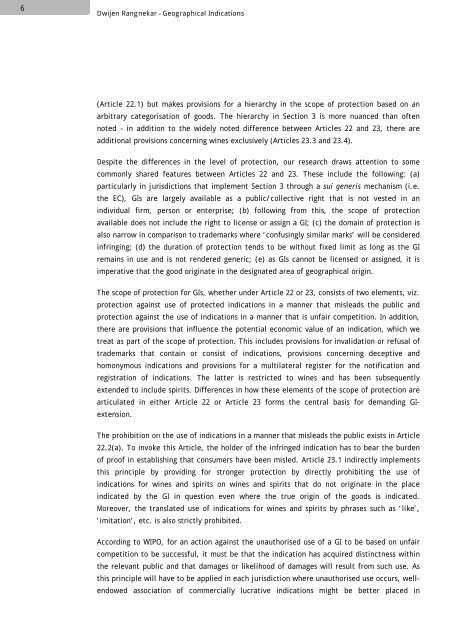Geographical Indications
Geographical Indications
Geographical Indications
Create successful ePaper yourself
Turn your PDF publications into a flip-book with our unique Google optimized e-Paper software.
6Dwijen Rangnekar - <strong>Geographical</strong> <strong>Indications</strong>(Article 22.1) but makes provisions for a hierarchy in the scope of protection based on anarbitrary categorisation of goods. The hierarchy in Section 3 is more nuanced than oftennoted – in addition to the widely noted difference between Articles 22 and 23, there areadditional provisions concerning wines exclusively (Articles 23.3 and 23.4).Despite the differences in the level of protection, our research draws attention to somecommonly shared features between Articles 22 and 23. These include the following: (a)particularly in jurisdictions that implement Section 3 through a sui generis mechanism (i.e.the EC), GIs are largely available as a public/collective right that is not vested in anindividual firm, person or enterprise; (b) following from this, the scope of protectionavailable does not include the right to license or assign a GI; (c) the domain of protection isalso narrow in comparison to trademarks where ‘confusingly similar marks’ will be consideredinfringing; (d) the duration of protection tends to be without fixed limit as long as the GIremains in use and is not rendered generic; (e) as GIs cannot be licensed or assigned, it isimperative that the good originate in the designated area of geographical origin.The scope of protection for GIs, whether under Article 22 or 23, consists of two elements, viz.protection against use of protected indications in a manner that misleads the public andprotection against the use of indications in a manner that is unfair competition. In addition,there are provisions that influence the potential economic value of an indication, which wetreat as part of the scope of protection. This includes provisions for invalidation or refusal oftrademarks that contain or consist of indications, provisions concerning deceptive andhomonymous indications and provisions for a multilateral register for the notification andregistration of indications. The latter is restricted to wines and has been subsequentlyextended to include spirits. Differences in how these elements of the scope of protection arearticulated in either Article 22 or Article 23 forms the central basis for demanding GIextension.The prohibition on the use of indications in a manner that misleads the public exists in Article22.2(a). To invoke this Article, the holder of the infringed indication has to bear the burdenof proof in establishing that consumers have been misled. Article 23.1 indirectly implementsthis principle by providing for stronger protection by directly prohibiting the use ofindications for wines and spirits on wines and spirits that do not originate in the placeindicated by the GI in question even where the true origin of the goods is indicated.Moreover, the translated use of indications for wines and spirits by phrases such as ‘like’,‘imitation’, etc. is also strictly prohibited.According to WIPO, for an action against the unauthorised use of a GI to be based on unfaircompetition to be successful, it must be that the indication has acquired distinctness withinthe relevant public and that damages or likelihood of damages will result from such use. Asthis principle will have to be applied in each jurisdiction where unauthorised use occurs, wellendowedassociation of commercially lucrative indications might be better placed in









